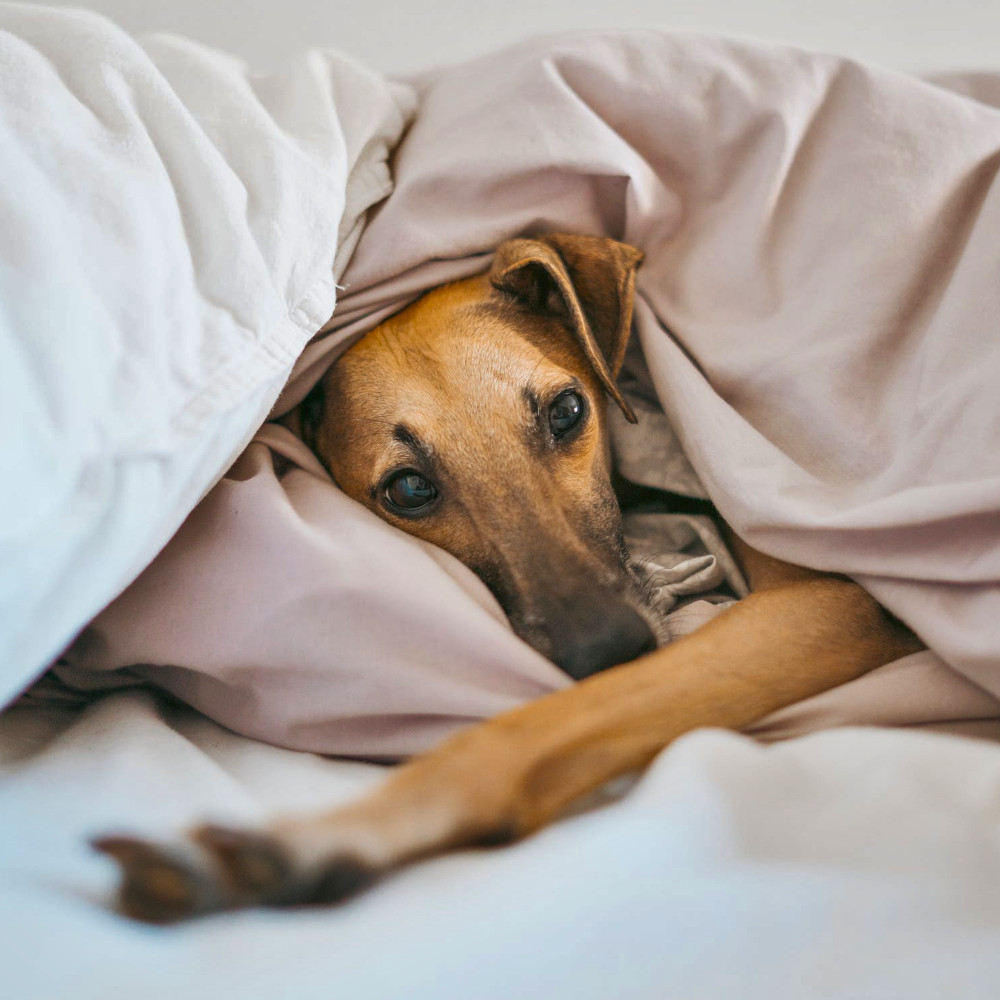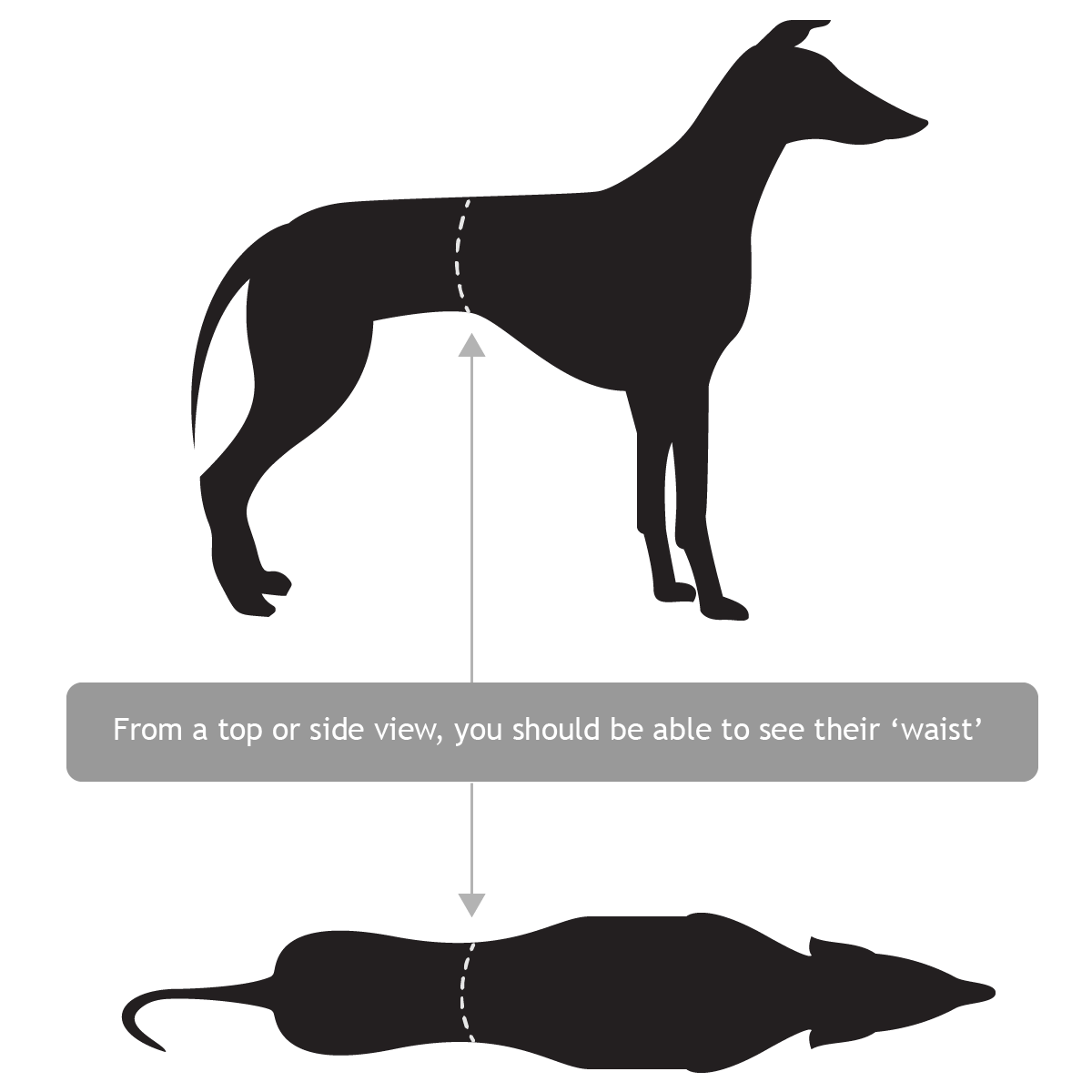
There are many things to consider to ensure your greyhound is healthy. This includes diet, vaccinations, parasite control, and keeping your greyhound cool in the summer and warm in the winter.
Diet
The basis of your greyhound’s diet should be a high quality balanced premium commercial dog food that is appropriate for their life stage (e.g., adolescent, adult, senior) and health status.
To avoid gastrointestinal upsets, it is best to continue feeding the diet that your greyhound ate at the adoption centre and, if you are changing diet, gradually transition to a new diet over 7-10 days.
Never feed your dog just before or after exercise as this can cause gastric torsion (twisted stomach), which is very painful and can be fatal if left untreated. Signs to look for are bloating, restlessness and vomiting. This is a veterinary emergency.
For more information on feeding your greyhound read the following articles:
- What should I feed my dog?
- What should I know before feeding dog treats?
- Why is chocolate toxic to dogs and other pets?
- Should I feed bones to my dog?
Ideal condition and weight
Greyhounds are naturally slim but a thin fat layer should cover the body so that ribs and the tip of the hips are just visible. This means that they can be a couple of kilograms heavier than what their racing weight was (if they raced) but it is essential not to over-feed them as overweight dogs suffer health problems. Also, from a top or side view, you should be able to see their ‘waist’.

Vaccination
Like any other dog, your greyhound needs vaccination against the main canine diseases including Parvovirus, Distemper and Hepatitis. Greyhounds adopted from a reputable rehoming group will have been vaccinated against these and Kennel Cough (C5 vaccine). Check to make sure your greyhound has been vaccinated and when their next vaccination is due.
Make sure you keep the vaccination certificate and present it to your veterinarian at the time of the next vaccination.
For more information, see What vaccinations should my dog receive?
Intestinal worms
The most common intestinal worms in dogs are roundworm, hookworm and tapeworm including Hydatid tapeworm.
Hookworm may be present in many greyhound training and rearing establishments. Hookworm larvae can migrate from the gut and lay dormant in tissues such as muscles, where they are not affected by worming medication. These dormant larvae can become mobile and move back into the gut during times of stress, e.g. rehoming. These latent infections can persist for years. Thus, although it is generally advised to worm your pet for intestinal worms every three months, it is recommended to worm your new greyhound monthly for several months to reduce the risk of environmental contamination and recurring gastrointestinal disease due to hookworm.
Symptoms of hookworm infestation include failure to gain weight, or weight loss, loss of appetite, and recurrent diarrhoea which is often dark and tarry (looks like tar) but can be just loose or runny. Other clinical signs include a painful abdomen or just a general failure to thrive.
Not all worming treatments will cover all worms, so best to consult your vet, particularly if your greyhound is showing any of the above symptoms. Be sure to find out from the adoption centre when your greyhound received their last worming treatment.
Heartworm
Heartworm can cause severe disease as they live in the heart, lungs, and associated blood vessels. This disease is spread by mosquitoes and so may be difficult to prevent. Contact your local vet to find out if heartworm is common in your area and, if it is, then it is essential that your dog receives preventative treatment. However, this must not be given until a blood test is done to ensure your dog is not already infected, as some preventative treatments can cause a reaction if given to dogs who already have heartworm. If your dog came from a heartworm-affected area, it is a good idea to talk to your veterinarian about what, if anything, should be done (for example, testing).
Fleas and ticks
Fleas are external parasites that live on the skin and survive by feeding on the blood of animals. Fleas can cause intense skin irritation leading to scratching and skin problems. It is likely that you will need to use a preventative flea product on an ongoing basis throughout the year, to prevent infestation. It is also important to check for fleas regularly. Your veterinarian can give you advice about the most suitable product for your pet and how often this should be applied (such as monthly). Flea treatments include spot-on applications, sprays, oral medications, collars and shampoos. All bedding must be washed at the same time your dog is treated.
For more information, see How do I stop my pet from getting fleas?
If you live in an area where there are paralysis ticks, then it is essential to use regular preventative treatments as well as check your dog for ticks every day. Your veterinarian can give you advice about the most suitable product for your pet and how often this should be applied.
For more information on ticks read: How can I protect my dog or cat from tick paralysis?
Grass seeds
During spring, grass seeds can become embedded between your greyhound’s toes or become lodged in their ear canals. When walking, avoid areas with long grass which have seeds, especially wild oats. Signs that your greyhound might have a grass seed problem include lameness, paw licking and swelling of the affected area and head shaking, tilting and scratching an ear if a seed has lodged inside the ear. If you noticed these signs, please seek veterinary advice as soon as possible.
Hot/cold conditions
Greyhounds have very little body fat and, therefore, are prone to cold stress. If your greyhound curls up in a tight ball, you know that they are feeling the cold. If the temperature is below 15°C, a dog coat is essential. Be sure to remove the coat when they come inside to a warm house or if they go for a run. As a general rule of thumb, if you require a coat, so will your greyhound.
In summer, dogs can become heat stressed as panting may not dissipate heat sufficiently. Bringing dogs inside to air conditioning when the temperature exceeds 35°C is the best option or if dogs need to remain outside, then there must be sufficient shade, cool water and providing a paddling pool full of water is a great way to cool off.
Grooming and nail care
Greyhounds do not need daily brushing and should only be washed if they need it, which is usually rare. If a wash is needed, be sure to use dog, not human, shampoo, with no or low scent.
Your greyhound’s nails may need to be clipped, although this is less likely to be needed if you frequently walk your greyhound on a hard surface (such as the pavement). Check with your veterinarian if your greyhound’s nails need to be clipped on a regular basis.
Dental care
Greyhounds often suffer dental problems. Tartar build-up is common which can lead to gum disease. So be sure to ask your veterinarian about the condition of your greyhound’s teeth and how you can best take care of them to help prevent serious problems developing.
For more information see How should I take care of my cat or dog’s teeth?
Foot problems
Some greyhounds may be prone to foot problems, especially if they are older and have been housed on concrete most of their lives. Look out for lameness, reluctance to walk as well as paw chewing as these are signs that suggest something could be wrong – it is best to seek veterinary advice as soon as possible.
Exercise
Not all greyhounds want a lot of exercise, so it is best to gauge what your individual dog needs. As a minimum, 30 minutes per day is recommended, but ideally a walk morning and night should be the routine. Greyhounds are built for speed so tend not to have much stamina. If you want a jogging partner then best to build them up gradually with short runs to start with. Always keep a firm hold of the leash and be aware of any potential hazards which may arise. Any dog should be under the control of their owner or a responsible person over 16 years of age.
Never allow your greyhound off leash unless in a (very) secure area. Off-leash parks (even fenced ones) can be risky, especially if small and large dogs are not separated.
In terms of equipment, it is recommended to use a front-attaching harness instead of a flat collar, as this avoids placing pressure on the neck and the possibility of your greyhound slipping their collar and escaping. The most important thing is to ensure the harness is fitted correctly so that it sits in the right position and is not too tight or loose. Head halters are not recommended as these are not comfortable for most dogs and can’t be used if a muzzle is required. Extendable leashes are also not recommended as they can injure your dog, yourself and can snap resulting in a greyhound on the loose.
If you and your greyhound are feeling in need of other greyhound company, there are greyhound walking groups in most capital cities with several more likely to be set up in the future or you could start your own. These are really helpful if socialisation isn’t going as well as hoped for. Talk to the shelter or rehoming organisation staff about the closest one to you. For more information read: How do I communicate with my dog?
Enrichment
In addition to physical exercise, it is essential for your greyhound’s welfare for them to have mental stimulation. Furthermore, bored dogs can be destructive by digging and chewing, as well as barking. Enrichment can be in many forms and may include toys and specially designed food mazes. Hollow toys (e.g., a Kong or treat ball) are very useful as you can place food inside, which may take some time to dislodge creating enjoyment and interest. Treat balls are also fun for dogs and can keep them occupied; making frozen food ice blocks can also provide good entertainment, especially during summer. Remember to allow for any food delivered as treats or in enrichment toys as part of the daily diet to avoid overfeeding.
Essential documents and certificates
It is a good idea to start a folder to keep all relevant documents concerning your new greyhound in the one place. It is also handy to have your veterinarian’s contact details somewhere you know you can quickly access such as your mobile phone, fridge magnet or pin-up board. A calendar for reminders such as vaccinations or annual health check-up is useful too.
Desexing
Greyhounds adopted from a reputable rehoming group will have been desexed. Ensure you retain your greyhound’s desexing certificate as this may be required for a reduction in council registration fees.
Microchipping
Greyhounds adopted from a reputable rehoming group will have been microchipped. The contact details must always be current to ensure your greyhound is returned to you should they become lost. Also, microchipping is compulsory in some jurisdictions, so when you apply for registration, you will need to present the microchip form.
Council registration
Retain the council registration form in case your dog loses their registration tag and you need to order another. Some boarding kennels may also require dogs to be registered.
For more information, please see our Greyhound adoption booklet.
